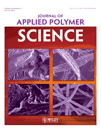Effect of 2,2-dimethyl malonate on the volume shrinkage control of the CaCO3/unsaturated polyester resin composites
Abstract
Shrinkage is critical to the unsaturated polyester resin (UPR) composite materials. Shrinkage influences the surface appearance, thus leading to warpage, internal cracks, and depression on the surface of the composite materials' products. Some studies and technologies have been conducted to controll the shrinkage. In this study, we presented 2,2-dimethyl malonate as an anti-shrinkage agent, which was different from the previous thermoplastic macromolecular agents. The shrinkage level of the CaCO3/UPR matrix dropped to zero with 12% 2,2-dimethyl malonate by mass of UPR. The bending strength of CaCO3/UPR matrix with 2,2-dimethyl malonate was also higher than that with the same adding amount of commercial thermoplastic agents at the low-shrinkage level (below 0.25%) and the micro-shrinkage level (below 0.08%). A reaction including two stages was proposed on the supporting of DSC and FTIR investigations. From the analysis results, we deduced that the first stage of the reaction was the esterification between 2,2-dimethyl malonate and UPR, which did not occur in the UPR containing general thermoplastic anti-shrinkage agent, and the second stage was restraining the cross polymerization of UPR, same to the reaction processes of general macromolecular anti-shrinkage agents. © 2011 Wiley Periodicals, Inc. J Appl Polym Sci, 2011




